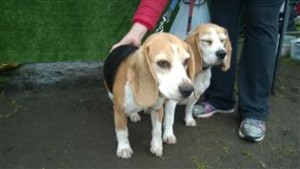
 Scent hound category evolution and current state
Scent hound category evolution and current state
The scent hound category is one of the largest and oldest dog breed categories you can find.
The most complete list of this category of breed is kept by the Fedraton Cynnologique Internationale (FCI)
While dogs have evolved from the wolf over 20,000 years or so, they weren’t classified into specific categories until the mid 15th century. though that is a lot longer than many of the AKC breeds have been around, and many of the 15th century dog breeds are now extinct.
For hunting dogs the two main categories are Sight and Scent hound. While many dogs have exceptional hearing, there is no hearing hound class.
The main difference between sight and scent hounds are that each group of dog was mainly breed to use that specific sense in helping their owner hunt a specific type of animal.
Sight hounds are predominantly used at the start of a chase. They have to visually perceive the prey then alert the owner. They are often fast and narrow dogs that once aware of prey chase the prey down.
SCENT Hound physical traits for hunting
Scent hounds are almost the opposite in characteristics to sight hounds. Because of the wolfs exceptional sense of smell, it was relatively easy to breed dogs that could improve on this. Though by putting a focus on a dogs nose, the need for speed was much diminished. In fact most scent hounds are heavily weighted towards endurance.
They don’t have to run fast to catch prey before the prey disappears, because they can put their nose to the ground and track the animal over long distances regardless of where they hide.
SCENT HOUND and their exceptional noses
Scent hounds have large WIDE noses with deep, open nostrils. Compare this to sight hounds that have narrow heads with thin nostrils. While almost all dogs have great smell scent hounds have exceptional smell. The special sections in their nose for concentrating scents, the part of their brain for processing scents are all enlarged.
Typically the scent hounds lips are loose and moist to assist in picking up scent particles. This is why besides the rapid sniffing to accumulate sense particles into the nose, you may also find the dog quivering its lips when it stands in the direction of the prey, to accumulate more particles on its lips too.
TOP SCENT HOUNDS by scent receptors.
The greatest number of scent receptors i by the blood hound with 300 million scent receptors in their noses. Beagles have the same amount as the German shepherd dog at 225 million scent receptors. However the German shepherd tends to concentrate on guarding duties which is perhaps why it is not classified in the scent hound group.
Dachshunds have 125 million smell receptor cells, while a Fox terriers has 147 million of these cells.
But it is not always about the raw number of receptors. The overall system (including brain processing scent section) and the motivation of the dog to find the prey plays a large part in how much effort a given dog breed might exert in trying to track a scent.